As a home baker, I’ve always been fascinated by common ingredients. Cottage cheese is a staple in my kitchen. It offers many benefits beyond its usual uses. It can make baked goods more moist and nutritious. I remember my grandmother’s cottage cheese pancakes fondly. They were light and fluffy. The cottage cheese made the batter rich and creamy. This inspired me to use cottage cheese in baking. Let’s discover What cottage cheese do in baking.
Understanding Cottage Cheese Composition for Baking
Using cottage cheese in baking is special. It’s made by adding acid to milk. This makes the solids (curds) separate from the liquid whey. The mix has milk, cream, salt, and sometimes live cultures. It can have little to a lot of fat.
Protein Content and Structure
Cottage cheese is packed with protein. This makes it great for baked goods. The size of the curds changes the texture and feel of your baked items. Big curds make things creamier, while small ones are tangier.
Fat Content and Moisture Levels
The fat in cottage cheese matters for baking. Full-fat cottage cheese has less fat but more protein than sour cream or cream cheese. This helps make baked goods lighter and softer. The moisture in cottage cheese also affects the texture and how long your baked goods last.
Curd Sizes and Their Impact
The size of cottage cheese curds changes how your baked goods turn out. Dry, small curds are good for crispy or airy textures, like in crackers. Wet, large curds are best for moist and fluffy treats, like cheesecakes and cakes.
Knowing about cottage cheese’s protein, fat, and curd size helps in baking. It lets you make tasty and healthy baked goods. You can please your taste buds and stay healthy at the same time.
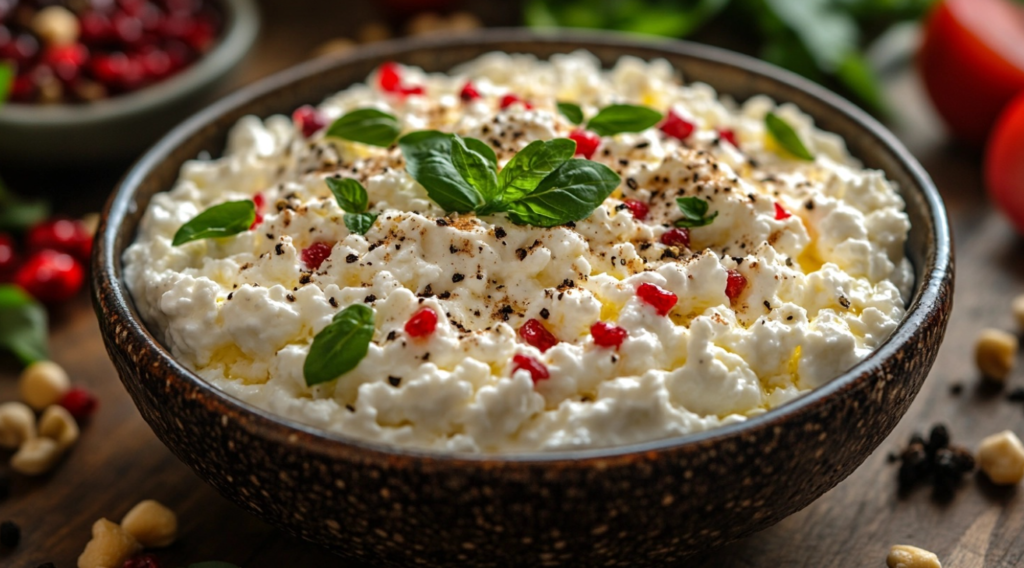
What Does Cottage Cheese Do in Baking
Looking to improve your baking? Try adding cottage cheese to your recipes. It’s great for both savory and sweet baked goods.
Cottage cheese adds moisture and a creamy texture. Its high protein helps make baked goods tender and satisfying.
It’s also a good substitute for milk or sour cream. This makes your baked goods healthier and tastier.
Cottage cheese keeps baked goods fresh longer. It’s perfect for making cottage cheese muffins, scones, or bread.
Next time you bake, use cottage cheese. It makes your baked goods moist and adds protein and nutrition.
Nutritional Benefits of Baking with Cottage Cheese
Cottage cheese is more than just a versatile ingredient. It offers many nutritional benefits that can make your baked goods healthier. It adds protein and calcium, making your treats better for you.
Protein Enhancement in Baked Goods
Cottage cheese is packed with high-quality protein. A 100g serving has 11g of protein. This makes it great for adding protein to your baked goods. It helps with muscle growth and repair.
The protein in cottage cheese baking also helps you feel full. This can reduce cravings and keep your diet balanced.
Calcium and Mineral Content
Cottage cheese is also full of important minerals like calcium, phosphorus, and potassium. A 100g serving of low-fat cottage cheese has 111mg of calcium. This makes it a beneficial option for the benefits of cottage cheese in baking.
These nutrients are good for your bones, muscles, and body functions. They make your baked goods even healthier.
Lower Calorie Alternative
Cottage cheese has fewer calories than butter and cream cheese. It has only 84 calories per 100g serving. This lets you use it to replace higher-fat ingredients without losing flavor or texture.
Using cottage cheese in your baking makes your treats nutritious and tasty. It’s a great way to make your baked goods healthier and more delicious. Discover the benefits of cottage cheese in baking and take your cooking to the next level.
Texture Enhancement in Baked Products
Cottage cheese is an excellent choice for baking, as it adds a unique texture to your treats and enhances their overall quality. Moreover, its high protein and fat content makes it incredibly versatile.
The protein in cottage cheese helps make baked goods light and firm, while the fat contributes to a tender and moist texture. In addition, its curd structure creates a fun mouthfeel.
Furthermore, incorporating cottage cheese into muffins, cakes, cookies, or even savory items like biscuits can elevate your baking. It brings a moist, rich, and tangy flavor, ultimately taking your baked goods to the next level.
| Baked Good | Texture Enhancement with Cottage Cheese |
|---|---|
| Muffins | Cottage cheese makes muffins tender, moist, and fluffy. It also helps them rise well. |
| Cakes | Cottage cheese adds softness and richness to cakes. It makes them velvety and moist. |
| Cookies | Cottage cheese makes cookies chewy and soft. They feel like cake but with a crisp edge. |
| Biscuits and Scones | Cottage cheese gives biscuits and scones a flaky texture. It also adds a tangy flavor. |
Using cottage cheese in baking can transform your treats. It adds moisture, tenderness, and a unique texture. Cottage cheese is a versatile ingredient that can elevate your baking.
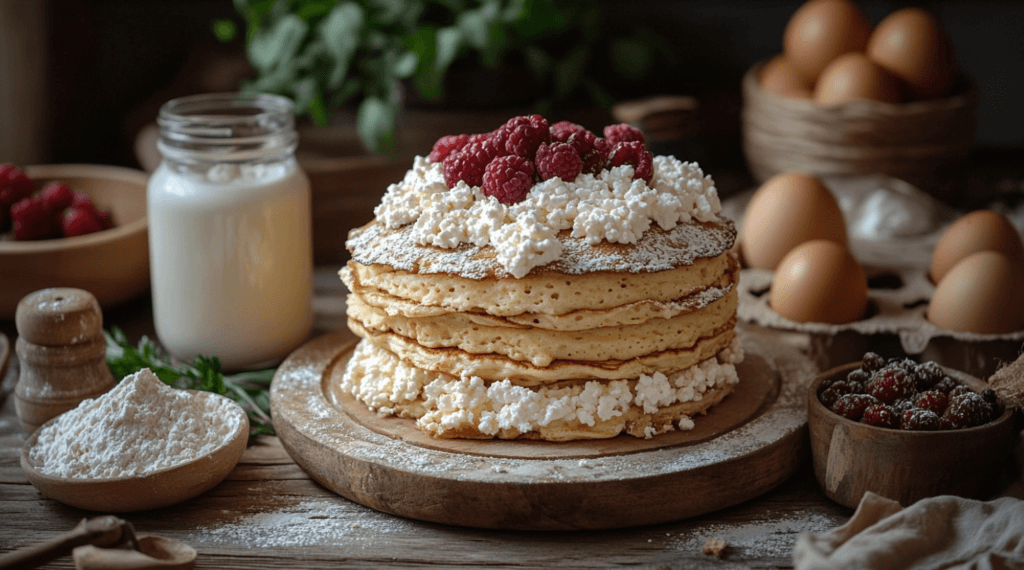
Moisture Control and Crumb Structure
Using cottage cheese in baking adds moisture. This makes your baked goods tender and tasty. The protein in cottage cheese keeps them moist, so they don’t dry out fast.
This helps your breads, cakes, and treats stay soft. It makes them more enjoyable to eat.
Impact on Shelf Life
The moisture in cottage cheese also makes baked goods last longer. It stops them from getting stale or dry too soon. This means you can enjoy your baked items for more days.
Creating Tender Baked Goods
Cottage cheese also makes baked goods tender. Its creamy texture mixes well into dough or batter. This creates a soft, melt-in-your-mouth feel.
It’s perfect for making tender cakes, muffins, scones, and more. This makes cottage cheese a great choice for soft-textured treats.
Adding cottage cheese to baked goods is smart. It boosts moisture, texture, and shelf life. This leads to a better baking experience. By using cottage cheese, you can make amazing baked goods.
Substituting Traditional Dairy Products with Cottage Cheese
Cottage cheese is a versatile ingredient. It can replace many traditional dairy products in baking. It helps reduce calories, increase protein, and change the texture of your recipes.
Using cottage cheese in baking has many benefits. It can replace sour cream, cream cheese, or yogurt. Blending it into the batter adds richness and moisture without extra fat and calories. For example, a half-cup of cottage cheese has 11 to 14 grams of protein. This is healthier than using butter and cream.
Cottage cheese also improves the texture and shelf life of baked goods. It makes them tender, moist, and fresh for longer. This is great for cakes, muffins, and quick breads, where keeping them moist is key.
| Ingredient | Cottage Cheese Substitute | Ratio |
|---|---|---|
| Sour Cream | Cottage Cheese | 1:1 |
| Cream Cheese | Cottage Cheese | 1:1 |
| Yogurt | Cottage Cheese | 1:1 |
When using cottage cheese instead of traditional dairy, use a 1:1 ratio. This means you can swap sour cream, cream cheese, or yogurt with cottage cheese. But, you might need to adjust the batter or dough’s consistency because cottage cheese has a different texture.
Using cottage cheese in baking lets you make tasty and healthy treats. They satisfy your cravings and are good for your health and waistline. So, next time you bake, try using cottage cheese as a cottage cheese substitute in your favorite recipes.
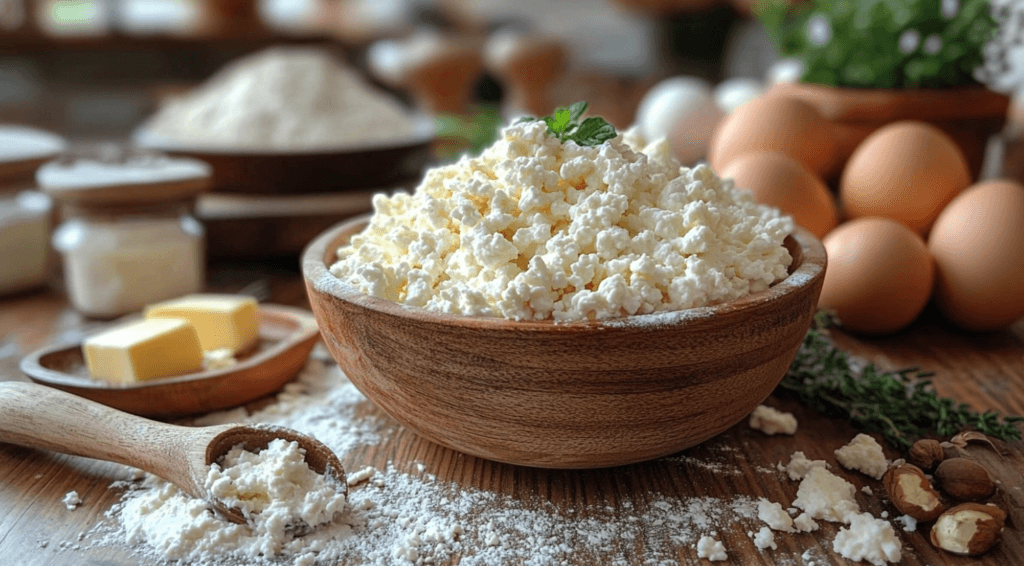
Best Practices for Baking with Cottage Cheese
When you bake with cottage cheese, some tips can make a big difference. Start by letting the cottage cheese warm up to room temperature. This makes it blend better into your mix.
Temperature Considerations
Letting cottage cheese warm up to about 70°F (21°C) is key. It blends better into your mix. This avoids cold spots that can mess up your baked goods’ texture.
Mixing Techniques
For smooth textures, blend or mash the cottage cheese first. This makes your mix uniform. But, if you want cottage cheese’s taste and texture, just fold it in.
Drain cottage cheese if your mix is too wet. This keeps your mix right. Don’t make it too wet or thick.
When swapping cottage cheese for other dairy, adjust the liquid. Start with a little cottage cheese and add more as needed. This gets your mix just right.
Common Mistakes to Avoid When Baking with Cottage Cheese
Cottage cheese makes baked goods better and healthier. But, there are a few things to watch out for. Let’s look at common mistakes to avoid when using cottage cheese in your recipes.
One big mistake is overmixing the batter. Cottage cheese’s curd can break down easily. This makes your baked goods tough and dense. Mix gently and stop when everything is just combined.
Another mistake is oversalting the recipe. Cottage cheese has a lot of sodium. So, you might need to use less salt. Taste the batter and adjust the salt to get the flavor right.
Don’t try to replace solid fats like butter or shortening with cottage cheese without changing other ingredients. Cottage cheese has more moisture. This can change how your baked goods turn out. If you use cottage cheese instead, you might need to adjust the recipe.
Also, think about the moisture content of your recipe. Cottage cheese adds a lot of liquid. You might need to use less of other wet ingredients or more dry ingredients to get the right consistency.
By avoiding these mistakes, you can make the most of cottage cheese in your baking. You’ll create tasty, moist treats that everyone will love.
| Key Considerations When Baking with Cottage Cheese | Tips to Avoid Mistakes |
|---|---|
| Overmixing the batter | Be gentle when folding in the cottage cheese, and mix only until just combined |
| Oversalting the recipe | Taste the batter before baking and adjust the seasoning as needed |
| Substituting cottage cheese for solid fats | Experiment with the recipe’s other ingredients to achieve the desired results |
| Moisture content | Reduce the amount of other wet ingredients or increase the dry ingredients as needed |
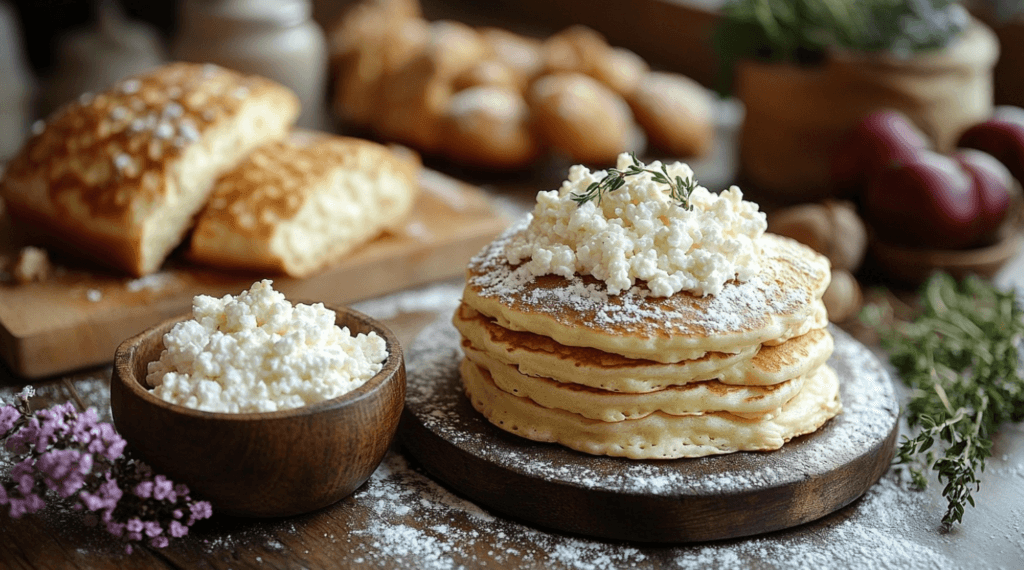
Types of Baked Goods Perfect for Cottage Cheese
Cottage cheese is great for both savory and sweet baked goods. It adds protein, moisture, and a creamy texture. It’s a wonderful addition to your baking.
Savory Applications
In savory baked goods, cottage cheese makes a big difference. Use it in breads, biscuits, and savory muffins. It makes the crumb tender and flavorful.
Sweet Treats and Desserts
Cottage cheese is also great in sweet baked goods. It’s perfect for cheesecakes, pancakes, and protein-rich muffins or cakes. It adds creaminess and richness to fruit-based desserts too.
Whether you’re baking with ricotta or cottage cheese, or just want to add cottage cheese to baked goods, there are endless options. Try different cottage cheese recipes to find new favorites.
Cottage cheese is versatile, making your baked goods better. Explore new flavors by adding this nutritious dairy to your baking.
Storage and Handling Tips for Cottage Cheese in Baking
When baking with cottage cheese, it’s key to store and handle it right. This ensures your baked goods turn out great. Whether you use full-fat cottage cheese or a lighter version, these tips will help you use it easily in your recipes.
Always keep your cottage cheese in the fridge and use it before it expires. It’s a dairy product that goes bad fast. So, keeping it cold is crucial to keep it fresh and safe to eat.
To get the best results, let your cottage cheese come to room temperature before mixing it into your dough. This makes it blend smoothly, giving your baked goods a nice texture.
If you worry about your recipe getting too wet, try draining the cottage cheese a bit. But don’t squeeze it too hard. You want to keep some moisture in.
Think about the fat content of your cottage cheese when picking a recipe. Low-fat or fat-free can work, but full-fat cottage cheese adds a richer taste. Try different types to see what works best for you.
By following these tips, you can make the most of cottage cheese in your baking. It adds protein, moisture, and texture to many recipes. Enjoy experimenting with it in both sweet and savory dishes.
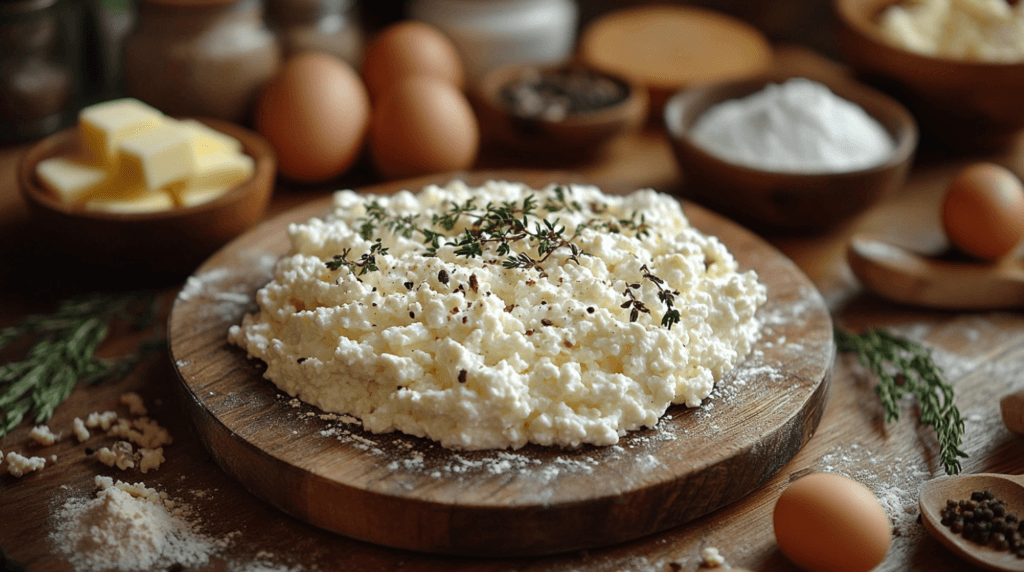
Conclusion
Cottage cheese is a great addition to baking. It makes your baked goods better in many ways. It adds protein, moisture, and texture.
Cottage cheese works well in many recipes, from savory breads to sweet desserts. This makes it a healthy choice instead of regular dairy.
Knowing how cottage cheese works in baking is key. It’s full of protein, which makes your treats healthier. It also keeps them moist and tender.
With the right techniques, you can use cottage cheese instead of other dairy. This opens up new possibilities in cooking.
Start using cottage cheese in your baking and see the difference. It’s perfect for making tasty snacks or desserts. It’s a great helper in the kitchen, making your food both delicious and good for you.
Begin your cottage cheese baking adventure. Find out how you can use it in your cooking. It’s a fun and rewarding journey.
FAQ
What is the protein content of cottage cheese compared to other dairy products?
Cottage cheese is packed with protein, offering 25g per cup. This is more than Greek yogurt’s 17g. It’s a top choice for adding protein to baked goods.
How does the fat and moisture content of cottage cheese impact baked goods?
Cottage cheese’s fat and moisture change baked goods’ texture and structure. Higher-fat types make them softer. Lower-fat ones add more protein and less fat. Its moisture makes baked goods tender and keeps them fresh longer.
What are the benefits of using different curd sizes of cottage cheese in baking?
Large curd cottage cheese adds moisture and creaminess. Small curd types are tangier. Cottage cheese’s unique texture can make baked items interesting.
Can cottage cheese be used as a substitute for other dairy products in baking?
Yes, cottage cheese can replace sour cream, cream cheese, or yogurt. It cuts calories but keeps things moist and adds protein.
How does the protein in cottage cheese contribute to the structure and texture of baked goods?
Cottage cheese’s protein helps baked goods stay moist and keeps them fresh longer. It’s key for their texture and structure.
What are some best practices for baking with cottage cheese?
Let cottage cheese warm up to room temperature for easier mixing. Blend it for a smoother texture if needed. Don’t overmix to avoid tough baked goods. Watch the salt, as cottage cheese already has sodium.
What types of baked goods work well with cottage cheese?
Cottage cheese is great for both savory and sweet baked goods. It’s perfect for breads, biscuits, and savory muffins. For sweet treats, try it in cheesecakes, pancakes, and protein-rich muffins or cakes.
How should cottage cheese be stored and handled for baking?
Keep cottage cheese in the fridge and use it before it expires. For baking, let it warm up to room temperature. If it’s too wet, drain it first.

